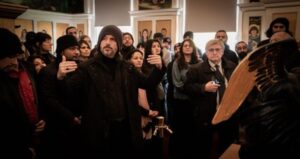WORLD: The Ahmadi Religion of Peace and Light. A drama and its characters
A group of believers in a new religion (not to be confused with the Ahmadiyya community discriminated against in Pakistan) are persecuted in various countries.
Human Rights Without Frontiers (HRWF) which has already denounced the persecution of this group in iran, Azerbaijan, Turkey… reproduces this article of Bitter Winter, adding some titles in the text.
by Massimo Introvigne and Karolina Maria Kotkowska

March 2024, the leader of the Ahmadi Religion of Peace and Light (AROPL) meets with scholars at the AROPL headquarters. On the right, Human Rights Without Frontiers’ Willy Fautré.
Bitter Winter (04.04.2024) – The date was May 24, 2023. At the usually quiet border of Kapikule between Türkiye and Bulgaria screams were heard, as the Turkish police was threatening and beating 104 women, men, and children standing in line to cross the Bulgarian frontier. They were not Turkish citizens. They had reached Türkiye fleeing different Muslim majority countries where they had been persecuted for their religious beliefs. They hoped to find salvation in the European Union, of which Bulgaria is a member state.
Gunshots were fired. People protested police brutality, some showing their bloody faces after the beatings. Happily, some reporters, alerted by the refugees’ co-religionists in the West, were able to get there. The story spread throughout the world, reaching the United Nations in New York.
Who were these desperate people? Why was their life in danger? It took time even for the international human rights organizations that received their appeals for help to understand. The fact was, they were part of a religious organization called the Ahmadi Religion of Peace and Light.
The Ahmadi Religion of Peace and Light (AROPL) has nothing to do with the Ahmaddiyya community in Pakistan
All human rights organizations throughout the world were familiar with the Ahmadiyya community, which is heavily discriminated against and persecuted in Pakistan. The similarity in the names caused some confusion. In fact, the Ahmadi Religion of Peace and Light has nothing to do with the Ahmadiyya community. The latter is a Sunni-derivative religious movement, while the AROPL is a Shia-derivative group. Their theology and history are different.
Nor can the AROPL be considered a sect of Islam. Scholars of religion distinguish between the “emic” point of view of the devotees and the “etic” (not to be confused with “ethic”) perspective of the outside scholarly observers. The emic point of view of the AROPL members is that they represent the true Islam, in fact the true universal religion. From the etic perspective of scholars, they are part of a new religion, as different from what is normally called Islam as Christianity is different from Judaism. There would be no Christianity without Judaism, yet Christianity is a different religion from Judaism. There would be no AROPL without Shia Islam, yet the AROPL is a different and autonomous religion.
In March 2024 we, together with other scholars from different countries, from Australia to Lithuania, were invited to a conference and field trip in the United Kingdom, where the AROPL has its universal headquarters, to listen to presentations by devotees and discuss with them. We then had a meeting with the leader of the religion. In this series, we present the history and beliefs of the AROPL and try to explain why it has been persecuted, not only in regions with a Muslim majority but even in such an unlikely country as Sweden.
The Ahmadi Religion of Peace and Light (1999): History
The Ahmadi Religion of Peace and Light finds its roots in Twelver Shia Islam. Twelver Shiites (which include more than 80% of present-day Shiites) believe that the legitimate successors of Prophet Muhammad, whose authority was denied and bloodily suppressed by the Sunnis, were the Prophet’s cousin and son-in-law Ali and his descendants who, with him, are honored as the Twelve Imams. They also believe that the Twelfth Imam, Mohammed ibn al-Hassan al-Askari, who “disappeared” as a child in the year 874, was not killed by the Sunnis as some secular historians claim but went into a state of “occultation” from which he will emerge in the end times. Many Muslims also expect that, when the appropriate time will come, the world will be ruled on behalf of God by an eschatological figure known as the Imam al-Mahdi, in short, the Mahdi. Some believe he will be preceded by yet another eschatological figure, the Yamani, just as Jesus was preceded by John the Baptist.
During the history of the Shia, several individuals claimed they had met the Twelfth Imam and had been appointed by him as his vicegerents or envoys, thus generating a variety of new religious movements. Several claimants to the role of the Mahdi also appeared. Scholars assume that in times and places of political crisis and chaos new religions are more likely to emerge.
Ahmed al-Hassan, the prophesied Yamani and the persecution in Iraq
In 1999, in the chaotic post-Saddam Iraq, Ahmed al-Hassan, a civil engineer born in 1968 in Basra, claimed to have physically met the Twelfth Imam, who had entrusted him with the special mission to proclaim publicly that he, al-Hassan, was the prophesied Yamani and to call people to pledge allegiance to the Imam al-Mahdi.

An early and rare image of Ahmed al-Hassan
For al-Hassan’s followers, the main evidence that he really received a mission from the Twelfth Imam is in his teachings and in the fact that his role and even his name can be found in Prophet Muhammad’s last Will, a text whose very existence is denied by (most) Sunnis but is attested and discussed in several traditional Shiite sources. Both Sunni and Shia sources confirm the intent of the Prophet Muhammad to write a will on a night referred to as “the calamity of Thursday” that would be a safety from misguidance before he died the subsequent Monday. While other Muslims dispute its authenticity, for the AROPL Muhammad’s will as preserved in Shiite sources is both genuine and all-important.
Since 2002, al-Hassan publicly denounced the Shia establishment in both Iran and Iraq led by scholars and Great Ayatollahs such as Khamenei and Sistani as morally and politically corrupt. For al-Hassan, these were “non-working scholars,” leading the Muslims astray. As a result, al-Hassan and his disciples were severely persecuted. The Shia establishment pushed the Iraqi security forces to raid the homes, arrest and attack the followers of al-Hassan and accused them of being involved in riots, including (under the name “Soldiers of Heaven”) in the so-called “Battle of Najaf” of 2007, with which al-Hassan himself denied any connection.
Many of al-Hassan’s followers were innocently killed, arrested without just cause, and jailed without due process. The Shia militias and those representing the Shia establishment were looking for al-Hassan, wanting to kill him as a heretic. Al-Hassan was lastly seen and photographed in Iraq in 2007, after which he went into hiding. Reportedly, he visited several countries and lived for a time in Sudan, while his followers in Iraq and internationally divided into different conflicting factions.
The early teachings of al-Hassan were somewhat enigmatic and open to different interpretations by his disciples. Some, with basis in al-Hassan’s own early texts, believed he was himself the Qaim, the “Riser from the Family of Muhammad,” an eschatological figure mentioned in Islamic prophecies as the one who rises and restores justice in the world during the end times and is the first in a series of Mahdis (divinely appointed guides) who rule an end-times Divine Just State. On the other hand, there are followers who testify that from the beginning of his public ministry, al-Hassan declared himself to be the prophesied Yamani. The Yamani, which means the “right-hand,” is a major prophesied eschatological figure whose role is to pave the way for the Qaim/Riser. The Yamani can also be called “the first Mahdi” and the Qaim “the second Mahdi,” but it is the Qaim who is the center of the new covenant with God.
Abdullah Hashem, a disciple of Ahmed al-Hassan, is the leader of the Ahmadi Religion of Peace and Light
After al-Hassan went into hiding in 2007, some of the Iraqi factions known as “the White Banners” or “the Office of Najaf” were infiltrated by the Iraqi government and started transmitting, including via a Facebook page, messages allegedly coming from him that were suspiciously different from his previous teachings. A split happened in the movement between those who maintained that the White Banners were still “authentic,” and that al-Hassan was communicating with them, and those who denounced the post-2007 messages as forged. The latter believed that the White Banners had no genuine communication with al-Hassan. They were led by Abdullah Hashem, an Egyptian-American disciple of al-Hassan. Hashem claimed that the White Banners / Office of Najaf was controlled and manipulated by the Iraqi government, that al-Hassan was not with them, and that they had fabricated his voice and the Facebook page.

Abdullah Hashem, the leader of the AROPL
In contrast with the White Banners, headquartered in Iraq, the group led by Hashem and currently headquartered in the UK, is known as the “Black Banners.” This creates another possible confusion, as both the “White Banners” and the “Black Banners,” i.e., the AROPL, recognize and venerate the figure of al-Hassan, although they interpret his role and mission differently. To complicate the situation even further, there are other minor groups claiming a relationship with the teachings of al-Hassan as well. The White Banners / Office of Najaf “excommunicated” Hashem in 2015 and again through a “Declaration of Disassociation” on April 18, 2023, which also targeted other groups. The Ahmadi Religion of Peace and Light is distinguished by the fact that it has the largest international following, while the White Banners are mostly Iraqis.
It is also important, when one hears of riots, political statements, and other problems in Iraq that involve “followers of Ahmed al-Hassan” to understand from whose group they originate. Unfortunately, Wikipedia and other generalist (and easily manipulated) sources do not help in this respect. This series, however, will helpfully clarify who is who, and shed some light on the unique beliefs of the AROPL.
***************************************************************
Massimo Introvigne (born June 14, 1955 in Rome) is an Italian sociologist of religions. He is the founder and managing director of the Center for Studies on New Religions (CESNUR), an international network of scholars who study new religious movements. Introvigne is the author of some 70 books and more than 100 articles in the field of sociology of religion. He was the main author of the Enciclopedia delle religioni in Italia (Encyclopedia of Religions in Italy). He is a member of the editorial board for the Interdisciplinary Journal of Research on Religion and of the executive board of University of California Press’ Nova Religio. From January 5 to December 31, 2011, he has served as the “Representative on combating racism, xenophobia and discrimination, with a special focus on discrimination against Christians and members of other religions” of the Organization for Security and Co-operation in Europe (OSCE). From 2012 to 2015 he served as chairperson of the Observatory of Religious Liberty, instituted by the Italian Ministry of Foreign Affairs in order to monitor problems of religious liberty on a worldwide scale.
